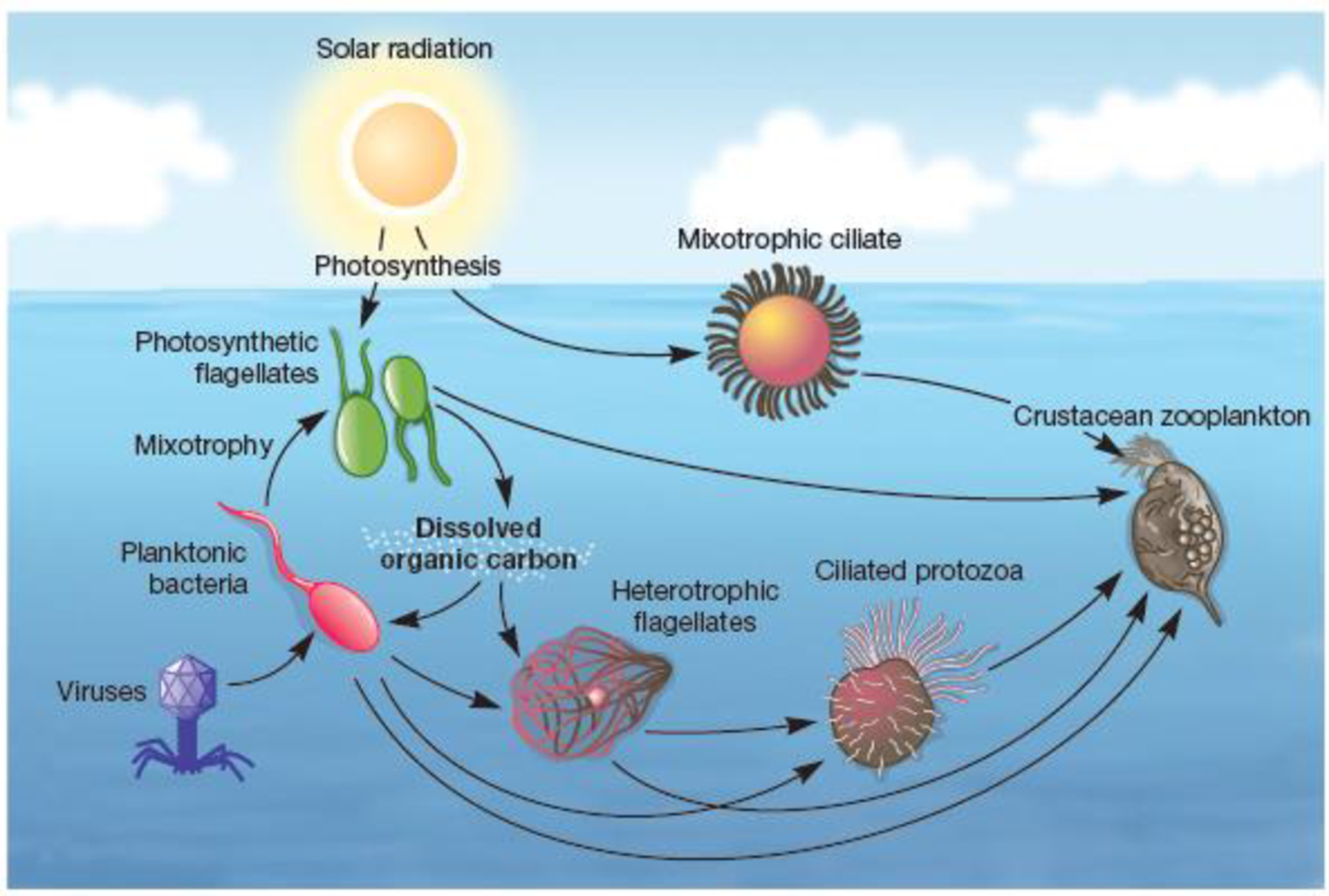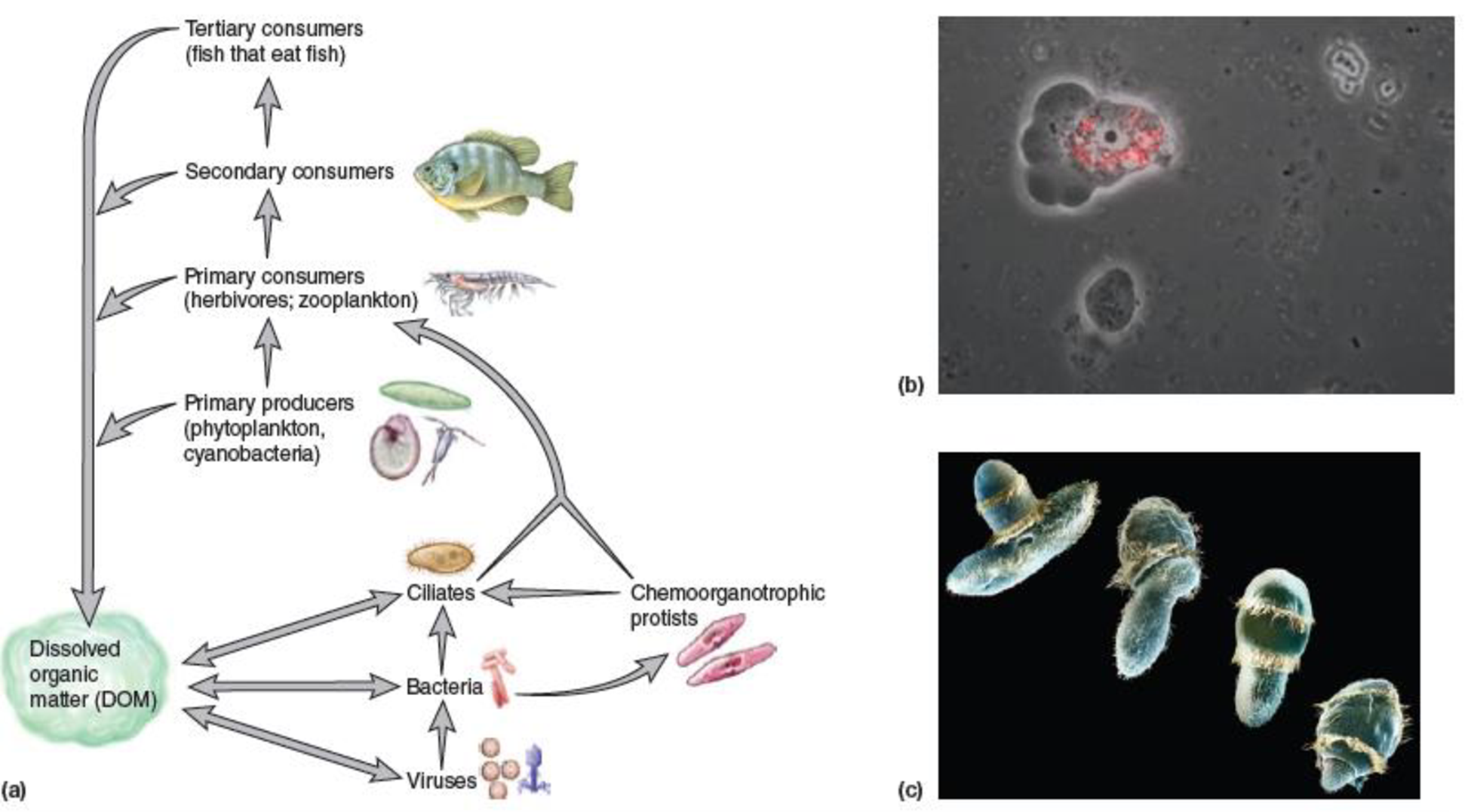
Concept explainers

Figure 30.15 Nutrient Cycling in Antarctic Lakes Is Performed Entirely by Microbes. Antarctic glacial lakes lack multicellular organisms, so all nutrient cycling is between various types of microbes, including bacteriophages. The surrounding environment provides some organic carbon.
List three major differences between this microbial loop and that found in the open ocean (figure 30.6).

Figure 30.6 The Microbial Loop. (a) Microorganisms play vital roles in ecosystems as primary producers, decomposers, and primary consumers. All organisms contribute to a common pool of dissolved organic matter (DOM) that is consumed by microbes. Viruses contribute DOM by lysing their hosts, and bacterial and archaeal cells are consumed by protists, which also consume other protists. These microbes are then consumed by herbivores that often select food items by size, thereby ingesting both heterotrophic and autotrophic microbes. Thus nutrient cycling is a complex system driven in large part by microbes. (b) Protists consume bacteria; in this case, a naked amoeba is consuming the cyanobacterium Synechococcus sp. which fluoresces red. (c) Protists consume protists; here, the ciliate Didinium sp. (rounded organism with two rows of cilia) is preying upon another ciliate, Paramecium sp.
Want to see the full answer?
Check out a sample textbook solution
Chapter 30 Solutions
CUSTOM PRESCOTT'S MICROBIOLOGY
- What is the opening indicated by the pointer? (leaf x.s.) stomate guard cell lenticel intercellular space none of thesearrow_forwardIdentify the indicated tissue? (stem x.s.) parenchyma collenchyma sclerenchyma ○ xylem ○ phloem none of thesearrow_forwardWhere did this structure originate from? (Salix branch root) epidermis cortex endodermis pericycle vascular cylinderarrow_forward
- Identify the indicated tissue. (Tilia stem x.s.) parenchyma collenchyma sclerenchyma xylem phloem none of thesearrow_forwardIdentify the indicated structure. (Cucurbita stem l.s.) pit lenticel stomate tendril none of thesearrow_forwardIdentify the specific cell? (Zebrina leaf peel) vessel element sieve element companion cell tracheid guard cell subsidiary cell none of thesearrow_forward
- What type of cells flank the opening on either side? (leaf x.s.) vessel elements sieve elements companion cells tracheids guard cells none of thesearrow_forwardWhat specific cell is indicated. (Cucurbita stem I.s.) vessel element sieve element O companion cell tracheid guard cell none of thesearrow_forwardWhat specific cell is indicated? (Aristolochia stem x.s.) vessel element sieve element ○ companion cell O O O O O tracheid O guard cell none of thesearrow_forward
- Identify the tissue. parenchyma collenchyma sclerenchyma ○ xylem O phloem O none of thesearrow_forwardPlease answer q3arrow_forwardRespond to the following in a minimum of 175 words: How might CRISPR-Cas 9 be used in research or, eventually, therapeutically in patients? What are some potential ethical issues associated with using this technology? Do the advantages of using this technology outweigh the disadvantages (or vice versa)? Explain your position.arrow_forward
 Biology 2eBiologyISBN:9781947172517Author:Matthew Douglas, Jung Choi, Mary Ann ClarkPublisher:OpenStax
Biology 2eBiologyISBN:9781947172517Author:Matthew Douglas, Jung Choi, Mary Ann ClarkPublisher:OpenStax Concepts of BiologyBiologyISBN:9781938168116Author:Samantha Fowler, Rebecca Roush, James WisePublisher:OpenStax College
Concepts of BiologyBiologyISBN:9781938168116Author:Samantha Fowler, Rebecca Roush, James WisePublisher:OpenStax College
 Biology: The Dynamic Science (MindTap Course List)BiologyISBN:9781305389892Author:Peter J. Russell, Paul E. Hertz, Beverly McMillanPublisher:Cengage Learning
Biology: The Dynamic Science (MindTap Course List)BiologyISBN:9781305389892Author:Peter J. Russell, Paul E. Hertz, Beverly McMillanPublisher:Cengage Learning Biology (MindTap Course List)BiologyISBN:9781337392938Author:Eldra Solomon, Charles Martin, Diana W. Martin, Linda R. BergPublisher:Cengage Learning
Biology (MindTap Course List)BiologyISBN:9781337392938Author:Eldra Solomon, Charles Martin, Diana W. Martin, Linda R. BergPublisher:Cengage Learning





